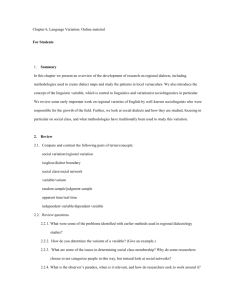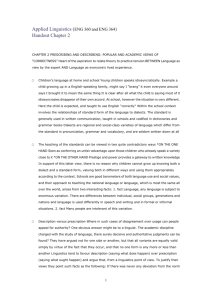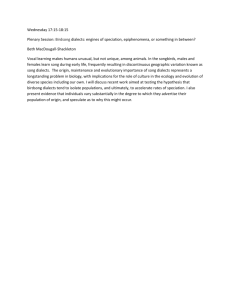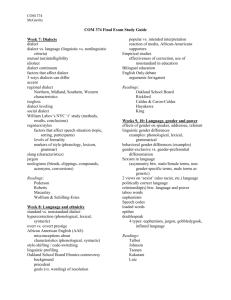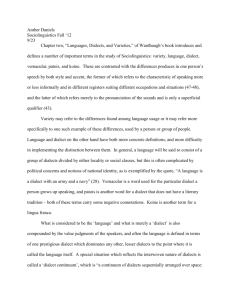زبان تخصصی کتاب - Tayebeh Mosavi Miangah (Ph. D)
advertisement
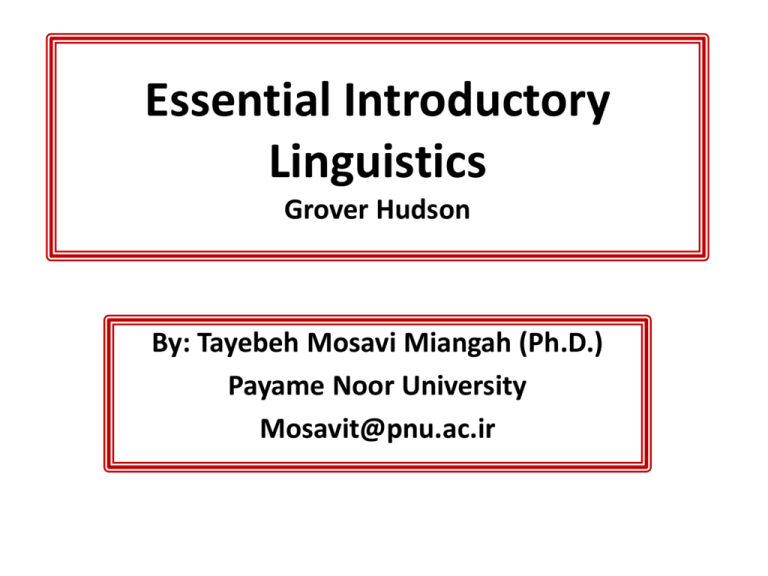
Essential Introductory Linguistics Grover Hudson By: Tayebeh Mosavi Miangah (Ph.D.) Payame Noor University Mosavit@pnu.ac.ir Chapter 6: Sentences and Syntax Unboundedness and Creativity • The number and length of sentences of a language is unbounded. • Unboundedness of syntax is the result of creativity. Three Aspects of Syntax • Grouping: grouping of words into meaningful and functional phrases (NP, VP, …) • Function: grammatical relations (subject, predicate, object, ….), parts of speech (noun, verb, adjective, ….), heads and modifiers • Word order: temporal or linear sequence of words Recursion in Syntax • Recursion: The reason for unboundedness of sentence length • Coordination: Expanding phrases by coordinating conjunctions (and, or) Abstractness of Syntax • The constituents and functions of sentences are not ordinarily concretely marked, not in speaking nor in writing. • The speakers’ knowledge of syntax concerns constituents and functions Knowledge of constituents Three kinds of evidence for groups and their constituents: • Replacement • Movement • Grouping ambiguity Replacement Replacement: a group may be replaced by a single word. I said I liked it. I said so. (Sentence by Adv.) Your cat hissed at me. It hissed at me. (NP by Pron.) Put them by the door. Put them there. (PP by Adv.) Movement • Movement: a group may appear in different places in different versions of a sentence Local farmers sell vegetables at the city market on Saturday. It is at the city market that local farmers sell vegetables on Saturday. It is vegetables that local farmers sell at the city market on Saturday. NP NP VP PP PP Grouping ambiguity • Grouping ambiguity: the same string may have two meaning based on different possible groupings “The man met the girl with a bunch of flowers.” Sense (A) sense (B) S NP – VP S NP – VP VP V – NP VP V – NP – PP NP Det – N – PP PP P – NP Knowledge of functions It is revealed in various ways, knowing the knowledge of: • Subjects (subject-verb agreement) • Head and modifiers: (the agreement of head, not the complement, with the verb) • Parts of speech (verb, noun, …) Function Ambiguity The ambiguity is based not on an ambiguous word (lexical) or an ambiguous grouping of words (grouping), but on an ambiguity of function. A Functionally ambiguous sentence: I like ice cream more than you. Sense (A): I like ice cream more than you like ice cream. Sense (B): I like ice cream more than I like you. Chapter 11: Adult Language Learning Distinction between foreign language learning (LL) and second language learning (LL): • A foreign language is learned outside of the community in which it is spoken (English in Iran). • A second language is learned in a community in which it is a commonly used language (French in Canada). Advantages of learning a second language: Learning inside and outside the classroom Putting to use what is learned Learning to get along in the community Therefore, in cases of second LL, there are more possibility to be successful in LL as children. Adults are less successful in LL than are children. Three sorts of evidence: • Rate of success: almost all children are successful in LL • Degree of success: children learn language completely, fluently, and without accent • Effect and spontaneity: children acquire language almost effortlessly Three explanations for the superiority of children in LL: • Cognitive differences • Affective differences • Biological differences Cognitive Differences Cognitive differences deal with processing the earlier knowledge about language. • Transfer: influencing the earlier knowledge on the acquisition of later knowledge. • Metalinguistic knowledge: conscious, analytic knowledge of the use of language Positive and Negative Transfer Positive transfer: Categories of second or foreign language are similar to those of the first language. It contributes to success in adult language learning. Negative transfer (interference): Categories of second or foreign language are different from those of the first language. It results in errors. The categories of the first and second languages are different in three ways: a) Absence of the category in second language (not problematic) b) Absence of the category in first language (problematic) c) Reinterpreting the category of the first language in second language (negative transfer) Metalinguistic knowledge Metalinguistic knowledge: Adults’ conscious, analytic, knowledge of their use of language like that of terminology or grammar. They can monitor their speech. Distinction between learning and acquisition: Language learning: the conscious and analytic approach of adults learning Language acquisition: the unconscious and spontaneous approach of children learning Affective Differences Affective differences deal with attitudes, emotions and personality, notably motivation and acculturation. Two sorts of motivation for adults language learning: • Integrative motivation: the desire to integrate into the community of the second language speakers • Instrumental motivation: the desire to benefit from the language learning (job, higher pay, status, etc.) Acculturation: becoming a member of one’s cultural group, of which his/her language is a part. Adult LL is an aspect of acculturation: adding a culture or becoming identified with a new social group. Some adults learners suffer from culture shock, who gradually may feel anomie, giving up their own culture ( a type of culturelessness and isolation) Biological Differences Biological Differences deal with a critical period for language learning. Critical Period: a time during which something must be learned. Two evidence for such period: a. Aphasias after the age of 11 result in permanent loss of some language ability b. Persons who do not acquire their first language before the age of 11 are unable to do learn it later. The critical period hypotheses a. Maturation version: after the critical period we lose the biological basis to learn in the spontaneous and effortless way of children. b. Exercise version: the critical period is valid only for the first language. The experience of learning the first language stimulates and establishes the biological basis for second language learning. Adults cannot learn like children Five evidence: 1. Variable success 2. Significance of motivation 3. Fossilization 4. Feral children 5. Research on learning 1. Variable success Comparison between: Limited success laborious adult LL Perfect success effortless child LL 2. Significance of motivation Children don’t need any motivation for LL. For adults motivation is very important. 3. Fossilization Adults make persistent errors in the use of language, but children don’t. 4. Feral children Cases of abandoned and isolated children growing up without language (Victor, Genie) These children never was able to learn language like other children. They support the critical period hypothesis. 5. Research on learning Results of research on testing LL ability of adults arriving in the US in different ages: • After the age of 7: sudden decline in scores • Before the age of 8: high scores (as natives) • After the age of 15: low scores Conclusion: the earlier arrival age, the higher scores Adults can learn like children Three evidence: 1. Creative construction 2. Natural orders 3. Successful adult learners 1. Creative construction Like children, adult learners are observed to test hypotheses about language resulting in novel and creative utterances. They produce things which could not possibly have been heard or learned by imitation. (like generalization patterns of language) “We putted the cookie there.” 2. Natural orders The similarity of the stages of the mastery in patterns of grammar in children and adults “I no like this one.” 3. Successful adult learners The existence of rare successful persons who achieve a command of a second language equivalent to that of native speakers (Joseph Conrad) Chapter 15: Six ways to get new words Openness: all languages continually get new morphemes and words through various ways as follows: A) new meanings in new forms Loan words Coinage B) new meanings in old forms Derivation/compounding/extension/narrowing/ba ckformation /bifurcation C) old meanings in new forms 1. new forms in syntax (Mail which is sent and received electronically by computer) 2. New forms in morphology (4 ways) (e-mail = electronic mail) (Please email me. *Please electronically mail me) Principle of limited novelty New meanings are preferred in old forms, and new forms are preferred in old meanings. A) limits of new form: phonology The grammar limits the possibilities of new phonological forms. New morphemes has to be adapted to the phonological patterns and the established inventory of phonemes of the language /lu:str/---> /lu:ster/ B) limits of new meaning There is not any evidence for such limits. New words in new forms: six ways A) New forms for old meanings: 1) clipping 2) acronyming 3) blending 4) wrong cutting B) New words with new meanings and new forms: 5) invention 6) borrowing Clipping Clipping: Shortening the spoken form of a word. pub, fan, pet Abbreviation: Shortening the written form of a word. Mr., etc., Dr. cm, kg • Clippings have the spelling suitable for English words, but abbreviations don't. • Abbreviations usually end in period, but clippings don't. Acronyming A phrase is replaced by a word based on the first letters of its words. Types of acronyms: • Word acronyms • Spelling acronyms • Two-level acronyms Word acronyms: pronounced as ordinary words, not single letters RAM ( random access memory) Laser (light amplification by stimulated emission of radiation) Unicef (united nations International Children's Emergency Fund) (ناجا ) نيروي انتظامي جمهوري اسالمي Spelling acronyms: pronounced as spellings, a sequence of letters TLC (tender loving care) ID (Identification Card) CD (Compact Disk) Two-level acronyms: the acronym which expresses meaning on two levels, as an acronym and as a simple word NOW (National Organization of Women) / the members are getting impatient SMOOSA (Save Maine's Only Official State Animal) / a large deer of north America Blending Making new words by taking the first part of the first word and the last part of the second word. Motel (motor hotel) Oxbridge (Oxford and Cambridge) Edutainment (education and entertainment) Smog (smoke and fog) Wrong cutting The process of language change in a novel way (or sometimes wrong way) in which the word boundary is mislocated. Nickname (from ekename) Lute (from Arabic 'al ud') Lariat (from Spanish la reata) Invention Inventing a word more or less from scratch. Proper names: kodak, ريكا Snob: (proud of social status) Barf (vomit) Logic of inventions Inventions are not always arbitrary, or symbolic relations of form and meaning. They may have an indexical or ironic relations with earlier words. Googol: indexical relation with a number having 100 zeros. Kleenex: indexical relation with 'clean' Zip: symbolic relation of form and meaning Form constraints on inventions The form of the invented words may not be new. They must conform to the phonological rules of the language. zap, dork: possible inventions tlak, sring: impossible inventions Disco, tomato: impossible inventions, possible borrowing Borrowing (loanwords) Taking a word from another language Process of borrowing: Adopting a loanword from a SL --> using it for the occasion --> finding it useful --> repeating it --> becoming familiar in TL Loanwords show the nature of political or cultural relations between SL and TL. They are evidence of the history. Nativization: Changing the pronunciation of loanwords to be conformed to the pronunciation of the TL. Nativization of spelling: In French borrowed word in English naive (with two dots above 'n') --> naive Loanwords in English Over 60% of English words are borrowed ones. From French: pork, beef, mutton, restaurant, rent, market, pay From Danish: sky, sister, thing, egg, odd, both From Latin: school, martyr, purse, mass, monk, creed From Greek and Latin: legal, necessary, history, popular, solar From Native American languages: Texas, tobacco, tomato, moose Etymology Origin: From the Greek word etymos Etymology is the study of the origin of words. OK (okey): acronym of 'oll korrect' = all correct reinforced in 1836 to stand for 'Old Kinderhook (US President 1836-40 New words recently entered in dictionaries: o bugbot: small mobile robot o cyber addiction: frequent use of the Internet as a psychological problem o hotel (v): use an office on a part time basis o infonaut: user of the Internet o v-mail: video-mail Chapter 25 Language Families How many languages in the world? Four to six thousand Three cases which make the exact count of world's languages difficult: 1. Chinese-type cases: 2. Swedish/Norwegian-type cases: 3. Arabic-type cases: diglossia 1. Chinese-type cases: different languages under one name Mutually unintelligible languages such as Mandarin Chinese, Cantonese, Shanghai, and Taiwanese are commonly called Chinese. 2. Swedish/Norwegian-type cases: one language under different names (Political matters) Swedish and Norwegian are dialects of one language. Hindi and Urdu are one language with two names, with two writing systems. 3. Arabic-type cases: diglossia Two varieties of one language are mutually unintelligible. It is extreme in the Arab world where the casual version of the language is different from the formal version. Language Families Language family: the set of co-descendant languages of an earlier language Causes for extending language families: 1. social separations between people 2. Language change over the years Dialects (mutually intelligible varieties of a language) languages (mutually non-intelligible varieties Language Dialect Dialect Language Language Dialect Dialect Dialect Dialect Language Language Language Language The process of diversification of language families Isolates: languages not yet shown to be part of the larger groups. Sibling languages (sister languages): the member languages of a language family having the same parent language Parent language (protolanguage): the language from which sibling languages descend Origin of language The approximate time of origin of language: 50,000 to million years ago • The Hypothesis of monogenesis: language was invented or developed only once in human history, so all languages descend from that one original language. • The Hypothesis of polygenesis: languages derive from multiple origins. Methods of Historical Linguistics 1. Mass comparison 2. Language reconstruction - Comparative method - Internal reconstruction The limits of history Language classification: the process of determining the grouping of languages on the basis of their shared descent from a parent language. Writing dates back to 5,000 years ago Classical Arabic and classical Latin were alike. Gradual change of them over time leads to two geographically separated modern varieties of Italic and Arabic languages. Mass comparison A simple comparison of basic vocabulary of several languages in order to find the phonetic and semantic similarities between them. Basic vocabulary: the words essential to human societies including numerals, body parts, kinship relations, and the like. Four reasons for semantic and phonetic similarities between language members of a family are as follows: 1. Borrowing (not for basic vocabulary) 2. Onomatopoeia (not for basic vocabulary) 3. Chance 4. Common descent 1. Borrowing: A recently borrowed word is very similar in sound and meaning to the equivalent word of the lending language. Television / تلویزیون Basic vocabularies are not usually borrowed. 2. Onomatopoeia (mimic words) Such words like ‘crash’ and ‘zip’ naturally tend to share meaning and sound from language to language. 3. Chance It is very unlikely for words of different languages to be similar by chance, because the relationship between sound and meaning in all languages is arbitrary. 4. Common descend Cognates in different languages have a common origin as they are similar in form and meaning. ‘Common descend’ evidence shows that English, Italian, and Hindi are sibling languages belonging to the Indo-European family. Many similarities of form would occur repeatedly, as regular phonetic correspondences, as well as the regularity of phonetic change. Regularity of phonetic change: the strong tendency for all phones of a type in a given environment to change identically. Language reconstruction The forms of a protolanguage are hypothesized by undoing the sound changes by which cognates are related. Two methods: • Comparative method • Internal reconstruction Comparative reconstruction Identifying regular phonetic similarities between the phones of cognates and hypothesizing the original phone (of the protolanguage) from which these evolve. In this method, protolanguage words are guessed to have existed before language change of the cognate words. Internal reconstruction Constructing only earlier forms of a single language by making comparisons within that language. Shine shone / shined Shone is the earlier form of the past . Shined has been created afterward as the result of analogical change or rule extension. Pidgin and Creole Languages Pidgin: A new rudimentary language created as the result of combining two languages – a foreign language spoken by few speakers and a local language spoken by many people with whom they have business relationships. Mi wokim haws. Yu wokim bret? ‘I am bulding (working) a house.’ ‘’Are you making bread?’ Lingua franca: one of the established pidgin languages which becomes widely known among the pidginspeaking community. It is a language of those who do not share a native language. Creole language: a pidgin language which becomes the native language of many people enriching with grammatical functions and vocabulary extension. Creole languages are among mixed languages which are exceptional cases. Pidgin lingua franca creole Chapter 26 Dialects and other Sociolects Three dimensions of language variation: Time - Society - Individual 2. Society 3. Individual 1. Time Historical variation Register Regional, ethnic, age, etc. variation Variation in Time Variation in time is one-directional. The result of lexical and grammatical changes in this dimension is linguistic variation. Linguistic variation: different ways of saying about the same thing. Speech community A group of people with almost the same language (who learn from and influence one another in all sorts of behavior including language.) Language change starts and spreads in a speech community. Language communities are based on the following factors: • • • • Geography Age Religion Gender Centers of change Factors which influence changes in speech communities are as follows: 1. Population size 2. Tight social networks 3. Removal from linguistic standards 4. Subordinate bilingualism 1. Population size • More populous speech communities, more changes • Language change is greater in cities than in the countryside. • Change is slower among the less numerous wealthier elites. 2. Tight social networks In tighter social networks, with more interaction among the members, more language change can be seen. 3. Removal from linguistic standards In more isolated groups, more language change can be seen. 4. Subordinate bilingualism Inequality in language use in different contexts as home, school, church, neighborhood, region, and nation, in which the language of school and nation often render the other languages subordinates. Result: lots of borrowing from dominant language to the subordinate one In coordinate bilingualism, both languages of nation and region are generally used for all purposes. Factors of language change in bilingual communities are as follows: 1. Subordinate bilingualism 2. Population insufficiency (to provide a rich social network for one of the languages) 3. Removal of one language from the linguistic standards of its traditional community. Sociolect Register: different linguistic levels of formality or styles Sociolect: the characteristic forms of the language of social groups Seven factors for arising sociolects within social groups: 1. Geography 2. Socioeconomic status 3. Ethnicity/race 4. Age 5. Occupation 6. Religion 7. Gender 1. Geography factor Dialects: the regional varieties of a language Every language of any geographic extent has regional varieties known as dialects. Every dialect is a variety of language Geographical features which severely limit travel (sea, mountain) can result in distinct dialects. How distinct languages are formed: with the passage of time, people speaking a single language when isolated from each other begin to lose mutual intelligibility. So their dialects become separate languages. • Mutual intelligibility is a continuum. Speakers of different dialects of a single language often make themselves mutually intelligible. • One of the dialects of a language (often the most prestigious one) is known as the Standard dialect. • Such a prestige derives from the greater cultural / economic influence of the region of the standard. 2. Socioeconomic status factor • The population of most large societies are classified according to socioeconomic status (SES). • The speech of most people may go up and down in SES continuum in different linguistic interactions and occasions. • Post-vocalic r is prestigious in New York. So the more prestigious the people, the more occasions of the prestigious pronunciation with r. 3. Ethnicity/race factor Three populous and separate racial groups in the US are: 1. African Americans 2. Hispanic Americans 3. European Americans Ebonics or Black English Vernacular (BEV) is the speech of African Americans spoken in discontinuous African American communities. It is not a regional but a ethnic variety of English. Characteristics of BEV: Be-deletion: be is absent except in two contexts (stressed be-verb, and habitual be) Habitual be: ‘he be late.’ means ‘he is late all the time.’ Consonant deletion: word-final consonant deletion ‘I foun’ something’ means ‘I found something.’ Origins of BEV. Three explanations: 1. May be an extension of features of regional American Southern dialect. 2. May be arose in the Pidgin English , a shared language between African people came from different regions of Africa to America. 3. May include characteristics of African languages Chicano English is characterized by: 1. The influence of Spanish 2. Code-switching between English sand Spanish Well boys, vamanos (let’s go) 4. Age factor The speech of teenagers is often noted by elder people as different, because they excessively make use of slang in their speech. ‘I got shotgun’ means ‘ I’ll sit in front next to the driver.’ 5. Occupation factor Occupational groups have their characteristic jargon. Legalese discourse: is characterized by avoidance of pronouns Medical discourse: has so many passive verbs 6. Religion factor Religious differences cannot alone lead to language differences except when accompanied by political separation which, in turn, results in social separation. Three cases: 1. Urdu and Hindi dialects leading to separate languages 2. Serbian and Croatian dialects leading to separate languages 3. Amharic and Argobba dialects leading to separate languages 7. Gender factor There are some gender preferential features of languages which may be used by both genders but are preferred by one of the genders. There are also some gender exclusive features which are only used by one of the genders. Examples of gender preferential differences in English: a. Lexical differences. Men: diesel , Bronco, women: rose, paisley b. Pitch. Higher in women and lower in men c. Non-standard usage. Women are more adherent to standard language (linguistic norms). d. Conversation. Women ask more questions, use more back-channeling, and interrupt men less than men interrupt them. Gender exclusive features can be seen in two languages of Sidamo and Japanese. Sidamo: gender exclusive lexical differences: gurda (women) / ado (men) for ‘milk’ Japanese: gender exclusive grammatical and lexical morphology chotto kite (women) / chotto koi (men) for ‘come here for a minute.’



